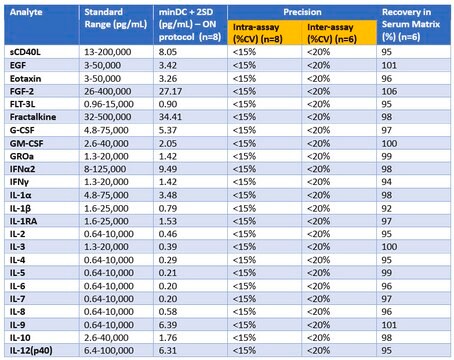RKTX2MAG-37K
MILLIPLEX® Rat Kidney Toxicity Magnetic Bead Panel 2 - Toxicity Multiplex Assay
The analytes available for this multiplex kit are: Albumin, AGP, ß2M, Cystatin C, EGF, Lipocalin-2/NGAL.
About This Item
Recommended Products
Quality Level
species reactivity
rat
manufacturer/tradename
Milliplex®
assay range
accuracy: 70-123%
standard curve range: 0.00-2 ng/mL
(EGF)
standard curve range: 0.01-10 ng/mL
(Lipocalin-2/NGAL)
standard curve range: 0.01-8 ng/mL
(Cystatin C)
standard curve range: 0.48-350 ng/mL
(β2M)
standard curve range: 1.37-1,000 ng/mL
(AGP)
standard curve range: 10.97-8,000 ng/mL
(Albumin)
inter-assay cv: <15%
intra-assay cv: <10%
(All other analytes)
inter-assay cv: <20%
intra-assay cv: <15%
(AGP)
technique(s)
multiplexing: suitable
detection method
fluorometric (Luminex xMAP)
shipped in
wet ice
Related Categories
General description
Panel Type: Toxicity
Specificity
Application
- Analytes: Alpha-1 Acid Glycoprotein (AGP), Albumin, ß2M, Cystatin C, EGF, Lipocalin-2/NGAL
- Recommended Sample type: urine
- Recommended Sample dilution: 1:500
- Assay Run Time: Overnight
- Research Category: Toxicity
Features and Benefits
Packaging
Storage and Stability
Other Notes
Legal Information
Disclaimer
Signal Word
Danger
Hazard Statements
Precautionary Statements
Hazard Classifications
Acute Tox. 3 Dermal - Acute Tox. 4 Inhalation - Acute Tox. 4 Oral - Aquatic Chronic 2 - Eye Irrit. 2 - Skin Irrit. 2 - Skin Sens. 1 - STOT SE 3
Target Organs
Respiratory system
Storage Class Code
6.1C - Combustible acute toxic Cat.3 / toxic compounds or compounds which causing chronic effects
Certificates of Analysis (COA)
Search for Certificates of Analysis (COA) by entering the products Lot/Batch Number. Lot and Batch Numbers can be found on a product’s label following the words ‘Lot’ or ‘Batch’.
Already Own This Product?
Find documentation for the products that you have recently purchased in the Document Library.
Related Content
Multiplex kidney toxicity assays detect nephrotoxicity biomarkers in small samples, minimizing time and costs for toxicity screening.
MILLIPLEX® toxicity assays advance liver, kidney, and genotoxicity research by simultaneously measuring multiple toxicity biomarkers.
Our team of scientists has experience in all areas of research including Life Science, Material Science, Chemical Synthesis, Chromatography, Analytical and many others.
Contact Technical Service









